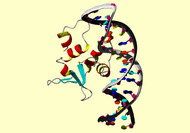
NMR Restraints Grid

 |
NMR Restraints Grid |
 |
Result table
| image | mrblock_id | pdb_id | cing | stage | position | type |
|
|
27866 |
2stt |
cing | 1-original | 1 | comment |
A. NOE interproton distance restraints The restraints are represented by square-well potentials with the upper (u) and lower (l) limits given by u=i+k and l=i-j where the numbers are entered in the order i,j,k. [Clore et al. (1986) EMBO J. 5, 2729-2735] The NOEs within the protein and between protein and DNA are classified into 4 ranges: 1.8-2.7 A (1.8-2.9 A for NOEs involving NH protons), 1.8-3.3 A (1.8-3.5 A for NOEs involving NH protons), 1.8-5.0 A and 1.8-6.0 A corresponding to strong, medium, weak and very weak NOEs. NOEs within the DNA are classified into 5 ranges: 1.8-2.5, 1.8-3.0, 1.8-3.5, 2.3-5.0 and 3.5-6.0 A, corresponding to strong, medium-strong, medium, weak and very weak NOEs. The atom notation follows standard PDB format. The # indicates a single wild card, and the * a full wild card. e.g. For Leu, HD* representes all the methyl protons; for a normal methylene beta proton, HB# represents the two protons. In these cases, the distances are calculated as sigma**-1/6 sums Note that the hard sphere van der Waals repulsion term ensures that the minimum lower limit for all distances is the sum of the relevant hard sphere atom radii. B. Torsion angle restraints The torsion angle restraints are derived from coupling constant and NOE data using the conformational grid search program STEREOSEARCH [Nilges, M., Clore, G.M. & Gronenborn, A.M. (1990) Biopolymers 29, 813-822]. They are represented by a square well potential [Clore et al. (1986) EMBO J. 5, 2729-2735]. The upper and lower limits are given by i+j and i-j respectively, where the numbers are entered in the order x,i,j,m. x is the force constant and m the exponent used to compute the torsion angle restraints target function. C. Three-bond HN-HA coupling constant restraints. The value of the coupling constant is given by the first number, and the second number has no meaning. D. Ca and Cb carbon chemical shift restraints: the Ca shift is given by the first number and the Cb one by the second. E. 1H, 15N and 13C resonance assignments. A. Interproton distance restraints
Contact the webmaster for help, if required. Thursday, May 9, 2024 12:18:41 AM GMT (wattos1)